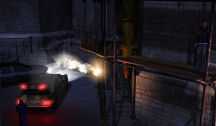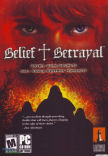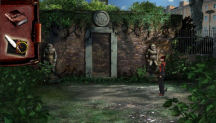Belief & Betrayal opens with New
York City journalist Jonathan Danter on the phone making impudent remarks
to his editor. “Jo” Danter is about to meet with the powerful Cardinal
Gregorio. The obvious question the gamer wants to ask is: why would any
editor assign this delicate interview to Jo, whose quirks are bound to
sabotage it? That’s just the first in a series of curiosities that will
send the gamer across the Atlantic to various locations – among them:
London, Venice, and Rome.
Jo is soon sidetracked by the death of his Uncle Frank. Frank Danter, a
cloak-and-dagger figure, was part of a sect investigating ancient
mysteries – in this case, dangerous secrets involving the Catholic Church.
Belief & Betrayal has three particular strengths. First, the
locations are eye-poppingly detailed and include portions of some of the
most beautiful sites in Europe. Second, the music is unusual and adds
atmospheric texture throughout. Third, the gamer is able to play as three
individuals in this third person, point-and-click adventure. Taking on the
roles of Jo, Kat (a wealthy amateur historian), and Damien (a computer
tech expert), adds intrigue and variety.
Tempting Fate with a Smile
Whether you like this game will depend greatly on whether you like Jo
Danter. Jo deals with horrible and unexpected events by joking about them.
I thought that Jo’s wisecracks provided an engaging contrast to the other
characters in the game – the ones who take themselves and events with
well-founded seriousness. An example – at one point a character says: “My
experience tells me that this manhole could lead to an ancient secret
crypt or something like that.” If Jo Danter had said this, you would
assume it to be a typically preposterous remark. Since, in fact, it is the
more sincere Kat who is the speaker, the gamer should probably expect the
manhole to end in a secret crypt. (Sidenote: if strict adherence to
realism is one of your chief demands in this sort of game, be advised that
Belief & Betrayal delves enthusiastically into the realms of legend
and historical reinterpretation.)
The game barrels along at a faster pace than most adventure games.
Several factors contribute to this effect: the multiple locations, the
style of the story, the frequent switching between characters, and the cut
scenes that advance the plot. The story starts out with common
conspiratorial themes, but takes some unexpected turns. And the ending is
not only quite surprising, but also purposely controversial.
Events in Belief & Betrayal are sometimes disjointed. A couple
of times I ended up at a new location and wasn’t sure why – though going
back to listen again to a conversation or remembering to read Jo or Kat’s
diaries provided an indication. Also, some characters appear so briefly
that a subsequent mention of their names becomes confusing. This is a game
in which a journal containing all previous dialogs would have helped
tremendously. So much plot exposition and character development takes
place during the dialogs that, if you aren’t listening and/or reading the
subtitles with great care, you will miss vital information.
Gawking Gamers
The environments in this game are well worth the visit. They feature
complex compositions in a muted palette and use unusual angles to give a
sense of scale. They range from a chic Manhattan loft, to London at night
with lighted windows in the mist, to the intertwined figures in the
frescos at the Vatican Museum. Many locations have animations, such as
cars zooming or pedestrians strolling. Character movements for the most
part are convincingly natural, though the main characters do occasionally
look as though they have been pasted into these enticing environments.
The music is orchestral and choral, and unusually magnificent – more
like the soundtrack for a movie. It suits the “grand conspiracy” theme of
the game, and heightens the mood in each location.
He Said, She Said
I found the voiceovers professional and suitable. I enjoyed Kat’s
clipped British accent and Jo’s frequent quips, delivered with
lackadaisical wryness. The children really sound like children. The
drunken Frenchman is profoundly Gallic. Conversations with the hooded monk
were memorable and affecting.
Lip sync is pretty much nonexistent, though this isn’t distracting
since you seldom see a close-up of the speaker’s face. You can click
through the dialogs. Unfortunately, you must listen all the way through
the repetitive “you can’t use this on that” statements when trying out
inventory items. Though a phrase or two here and there sounds stilted, the
translation is significantly better than the translation for this
developer’s previous adventure (Crime Stories: From the Files of Martin
Mysteré).
Belief & Betrayal is not a game for children. For instance, the
gamer will encounter a particularly bloody corpse, a prophylactic device
that is used as an inventory item, and occasional vulgarities.
Puzzles, Plus Problems
Puzzles are mostly inventory based and include using ideas/information
which can also be combined with inventory items. The inventory screen pops
up slowly – so slowly that it took me awhile to realize that it still was
available in close-up views. While using the ideas/information feature, I
found it extremely difficult to bring up the inventory. I had to move the
cursor (which becomes the “ideas” text) completely off the screen, and
then sit and wait for the inventory to become visible.
An electronic communicator must be mastered, along with a handful of
easy mechanical puzzles. The inventory puzzles are logical and I enjoyed
them – particularly the sequence with the magnetic keys. An added level of
difficulty came from the odd directional arrows in the game environments
-- I often couldn’t tell when the directional arrows were pointing to the
same location or to a different one.
Usually a single click on items provides a close-up view, though
occasionally you must double-click. You must repeatedly click on items and
complete all dialogs until a response is repeated. Otherwise you’ll miss
important clues. This includes clicking again on items that Jo says
won’t be helpful. Don’t trust him! Double-clicking sometimes induces Jo to
run to the location you want; other times he insists on walking while you
madly double-click.
A final frustration -- hotspots that don’t function with inventory
items until a triggering event has occurred. Late in Belief & Betrayal,
I was exasperated by how often I had to go back and use inventory items in
places where they hadn’t worked before.
As for glitches -- a few times, while using the spacebar to check that
I had found all the hotspots on the screen, the screen froze and I had to
return to the desktop and reload a saved game. Thankfully, saves are
unlimited – a wonderful gift to the gamer.
Quick List for Belief & Betrayal
A quick-paced thriller/adventure with the opportunity to play as three
different characters. Third person perspective, point-and-click interface.
Mostly inventory puzzles, plus combinations using an “ideas” list. No
timed puzzles, no mazes, no sliders, no sound matching puzzles, no color
based puzzles. Working with the inventory is frustratingly slow, and
moving the characters around can be confusing and inconsistent.
Elegant environments, including some famous sites in England, Italy and
France. A sometimes hard-to-follow, complex plot that (along with a few
religious and legend-based clichés) features plot twists and a surprise
ending. An aura of mystery and conspiracy, combined with an absurdist
sense of humor.
Brief, but dramatic cut scenes, good voiceovers, splendid background
music. You can’t die. A spacebar glitch that stops progress and requires
reloading from a previous save.
Two somewhat difficult puzzles: the clock puzzle, putting together
clues gathered at different points in the game, and the “Fire in the Borgo”
puzzle, involving details and implications.
No problems with installation. The manual is a must read. Unlimited
save slots.
Belief & Betrayal is aimed at gamers who like investigating
historical mysteries, uncovering conspiracies, and digging beneath the
surface of some of Europe’s most glamorous cityscapes.
Final Grade: B
July 2008
design copyright ©
2008
GameBoomers
Group




